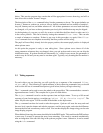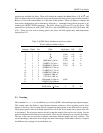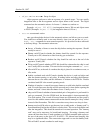
2
QUIRC User Guide
in cases where the background has been changing rapidly. It may also give better results if the dome
flat was not evenly illuminated (it is difficult to achieve even illumination at the 0.6m telescope). The
dark should be subtracted from the sky before division. The disadvantages of this technique are that
the sky flat shows the response of the detector to the OH airglow + thermal emission. In particular,
fringing may be present in certain configurations (e.g. 2.2m f/10 1:1), and fringing is something
which should be subtracted, not divided.
The number of bad pixels usually dictates a special technique for observing in which several exposures
are made of the field being studied, with each exposure shifted slightly from the others (dithering).
When the images are combined, the bad pixels in one image can be “filled in" with good pixels from
a shifted image. This technique also improves flat-fielding relative to a single long exposure at the
same position.
It is recommended that at the start and end of each night dome flats and darks be taken. The darks
should ideally be exposures of the same length as the object exposures. Even if the darks are not
directly used in the reduction, they will serve to show which pixels have high dark counts so that
these pixels can be included in a bad pixel mask. Dome flats are generally taken as a lights on/lights
off pair. Using this strategy results in a difference image (ON – OFF) which represents the detector’s
flat-field response to a source with color temperature of a few 1000 K, which is roughly the same
temperature as some of the sources being studied.
The shutter is a leaf type shutter, meaning than the center part of the aperture is open slightly
longer than the outside. Recent tests showed significant center-to-edge illumination differences for
integration times less than 1 second. Therefore, short exposures should be avoided, particularly when
exposing dome flats—it is far better to dim the lights with the domelight dimmer switch and use an
exposure of a few seconds than to use the dome lights at full intensity and an exposure which is less
than a second (this can introduce spurious radially varying structure into the flat-field). There is an
uncertainty in the timing of the shutter of the order of 10 millisec. Therefore, short standard star
exposures should also be avoided—on the 2.2m, the Elias standards may need to be slightly defocused
to allow reasonable exposure times in the broad filters.
At the 2.2m telescope there is a slight rotation in the nominal cassegrain rotator position (270). The
rotation was measured in February 1996 to be 0.883 degrees CCW (e.g., N is rotated 0.883 deg E of
vertical when displayed in the normal way). One could attempt to adjust slightly for this by changing
the rotator position, or adjust for it later during data reduction. If the precise rotation and scale is
important to the observations, one must measure this carefully during the run since the exact rotation
value is likely to change slightly between runs when the instrument is taken off the telescope and
remounted.
2.1 Detector Linearity, Saturation, Read Noise, Dark Current
Hard saturation of the detector occurs at 50,000 ADU’s. The total gain of the system results in a scale
factor of 1.85 electrons/ADU. Recent tests (2/96) showed the device to be linear to better than 1% for
values up to about 44,000 ADUs. However, the gain and illumination is variable across the array so
care must be taken so that parts of the array are not saturating when the average ADU value is getting
close to the non-linear region. The average value should be kept below 40,000 ADUs to ensure that
one is not saturating areas of the array. The average detector dark current is
0.8 electrons/sec, and
the read noise is
15 electrons rms.


















